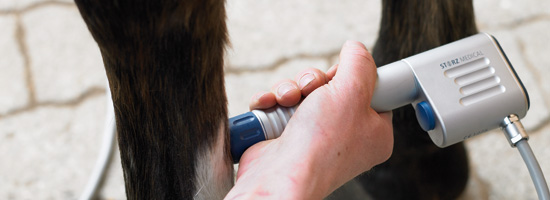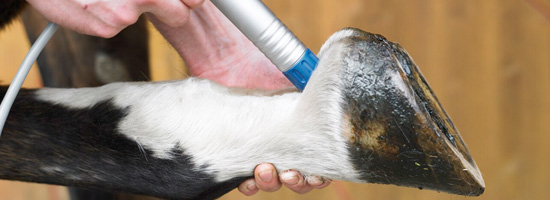Shockwave Therapy
 Overview
Overview
Extracorporeal shock wave therapy (ESWT) is a noninvasive modality used to stimulate healing, particularly in ligament, tendon, or boney structures. A shock wave is a high-energy sound wave that rapidly increases pressure as it travels through tissue”rapid and intense pressure changes result in cavitation, the formation and instantaneous collapse of tiny bubbles. Because these energy waves are generated from outside the body, this therapy is referred to as extracorporeal.
Firing shock waves repeatedly at tissue creates microtrauma. This stimulates an increase in blood flow and new blood vessel formation in the target area. Improved blood supply and provision of tissue nutrients are important features of every healing process. Although the exact mechanism of ESWT is not yet fully understood, researchers have identified specific biologic tissue responses including the release of inflammatory cytokines and growth factors, as well as regulation of tumor necrosis factor, interleukin, and bone morphogenic protein”all these substances stimulate active tissue inflammation.
While not a total panacea, ESWT does elicit active inflammation in a chronic, nonhealing injury”in effect, it jump starts the healing process. ESWT has been proven to speed healing and improve the quality of healing.
Applications
Although ESWT is best known for its value in managing proximal suspensory desmitis (inflammation of the suspensory ligament), veterinarians also use it to treat horses with various conditions such as tendon disease; degenerative joint disease of the distal hock, pastern, or coffin joints; collateral ligament injury; navicular syndrome; neck, sacroiliac, or lumbosacral injury; bone bruising; splint bone inflammation or fractures; bucked shins; or stress fractures. As an adjunct to multiple therapeutic approaches such as controlled exercise, non-steroidal anti-inflammatory medications, hot/cold therapy, and/or joint injections, ESWT offers a supplementary strategy to help resolve orthopedic injuries.
Musculoskeletal Treatment
Equine practitioners often use focused shock wave therapy when ligament or tendon injuries have failed to respond to other therapies, time, and rest. Controlled studies have demonstrated that ESWT application to significant soft tissue lesions stimulates healing with new collagen fibers and increased proteoglycan deposition, a main component of tendon or ligament repair. Inflammation and swelling are also notably reduced following ESWT of soft tissue and joint injuries.
Biologic regenerative therapy might be improved by pre-treating a ligament or tendon lesion with ESWT, then injecting stem cells or platelet-rich plasma, for instance, that provide a scaffold for tissue repair. After a prescribed rest period, this is followed up with two more ESWT treatments.
ESWT also has shown promise for improving soundness in horses with chronic or debilitating osteoarthritis. ESWT does not modify the disease process of degenerative joint deterioration, but when used in combination with other therapeutic medical approaches, studies have shown that horses receiving ESWT showed improvement in comfort and gait.
Pain Control
Controversial discussions exist about the role ESWT plays in providing pain relief following treatment. Studies have shown that ESWT is a useful noninvasive treatment modality for managing issues such as back pain. The concern for racehorses and sport horses, however, is that the pain relieving effects of ESWT could mask pain. This could enable a horse to overuse an injured limb with the potential for catastrophic breakdown. In addition, this pain relief might give an ESWT-treated equine athlete an unfair advantage over other competitors. To protect treated horses and to maintain a fair playing field, many equine regulatory commissions have banned ESWT immediately prior to competition.
Recent studies illustrate that ESWT relieves pain for 8-48 hours post-treatment, but after 48 hours lameness returns to the level seen prior to treatment. As studies continue to examine the pain-relieving effects of ESWT, regulatory rules likely will evolve to accommodate new information. Veterinarians recommend avoiding treating noninjured tissue whenever possible and to restrict exercise following recent treatment.
Wound Management
Another application of focused ESWT is directed at superficial wound care. Recent findings suggest that ESWT does not accelerate lower limb wound healing; however, studies demonstrated that less exuberant granulation tissue (proud flesh) developed on treated wounds, and treated tissue appeared healthier than nontreated controls. Thus, ESWT doesn’t necessarily speed up healing but it prevents conditions that might otherwise delay healing and epithelialization (skin cells covering the wound).
Shock wave therapy might have another benefit as an antibacterial treatment. Some veterinarians believe bombarding a wound with shock waves weakens protective barriers of bacterial cells to diminish microbial contamination and infection. This has exciting clinical implications for managing chronic, nonhealing wounds.
The Future of ESWT
As ongoing research is being conducted, additional applications, including treating conditions of the spine, for example, are demonstrating positive healing outcomes. ESWT applied in conjunction with known, effective medical therapeutic options has the potential to facilitate rapid recovery in an injured horse.
*Article courtesy of the TheHorse.com

